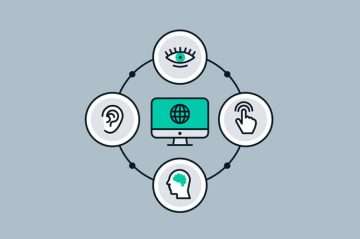
When the ADA was first passed in 1990, the world was a very different place, with the Internet in its early days. Since then, it has stepped into the center of everyday life: Many tasks can be done more quickly and efficiently online. While this has been a positive transformation, the law has failed to keep pace.
Because the ADA was written before the Internet became mainstream, it doesn’t address web accessibility, making it more challenging to keep the web open to people with disabilities. That said, the framework of the ADA provides protections for people with disabilities relating to web accessibility. In this post I will explain the basics of what exactly web accessibility is, and the tools used to ensure it. If you run an organization, whether a business or non-profit, I hope this will help you to think about building accessibility into your web presence.
Web access is litigated under Title III of the ADA. There is no explicit legislation extending the protections of the ADA to the Internet. For several years, the Department of Justice has promised regulations that would help guide organizations on how best to comply with the ADA online. In 2017 the DOJ announced it would no longer be releasing the regulations as promised. This has not stopped Plaintiffs from seeking to enforce their rights using the ADA and Rehabilitation Act. In this, 2017 was an important year for disability access to the Internet despite the DOJ’s disappointing inaction. That year, the U.S. Court for the Southern District of Florida found that the ADA does in fact apply to websites. In Gil v. Winn-Dixie, No. 16-23020, the court found for Plaintiff, finding that Defendant’s inaccessible website violated the ADA. This case is significant because it was the first time a plaintiff prevailed in a web access case under the ADA at trial. the court applied the Web Content Accessibility Guidelines 2.0 (“WCAG”) standards as a guideline for the defendant.
While there have been limited positive steps in the courts, there is still no definitive answer on whether Title III of the ADA applies to the web. That may soon change. In Robles v. Domino’s Pizza LLC, No. 17-55504, defendant Domino’s has asked the Supreme Court to weigh in on this issue. The 9th Circuit reversed the district court, ruling that the ADA applies to Domino’s web site and mobile application. It found that the ADA covers the services of a public accommodation, not services in a place of public accommodation. Disability lawyers on both sides of the bar will be watching closely to see if the high court will provide clarity.
While there aren’t specific legal requirements for web sites, there are widely used industry standards. WCAG is an important tool for web developers. These guidelines are an extensive set of standards that ensure a web page’s accessibility to various types of adaptive technology. For example, the guidelines recommend the inclusion of “alt text” (text describing the content of a graphic) for web pages using images. A specific web page can meet WCAG standards at 3 different levels: A, AA, and AAA. These are technical standards, so I won’t spend any time getting in to their specific definitions. In cases that have litigated the issue, such as Win-Dixie, it is most common to seek compliance at the AA level, recognizing that some content can’t reach the highest level of accessibility. WCAG is not law or regulation, but the guidelines are a useful reference point.
Organizations that build and manage their own web content should take advantage of the guidelines, and seek audits of their content for accessibility. For organizations that retain a 3rd party to manage their web content, it is important to include language in your contracts in which the 3rd party acknowledges they are familiar with WCAG, and will maintain your content at the AA level. It is also a good practice to include a statement on your web page often called an “accessibility statement.” This statement explains that your content is designed to be accessible, and provides contact information for users who discover obstacles.
In one form or another, the Internet will become accessible. When the law finally catches up, those organizations that proactively build accessibility into their services will be ahead of the curve.
